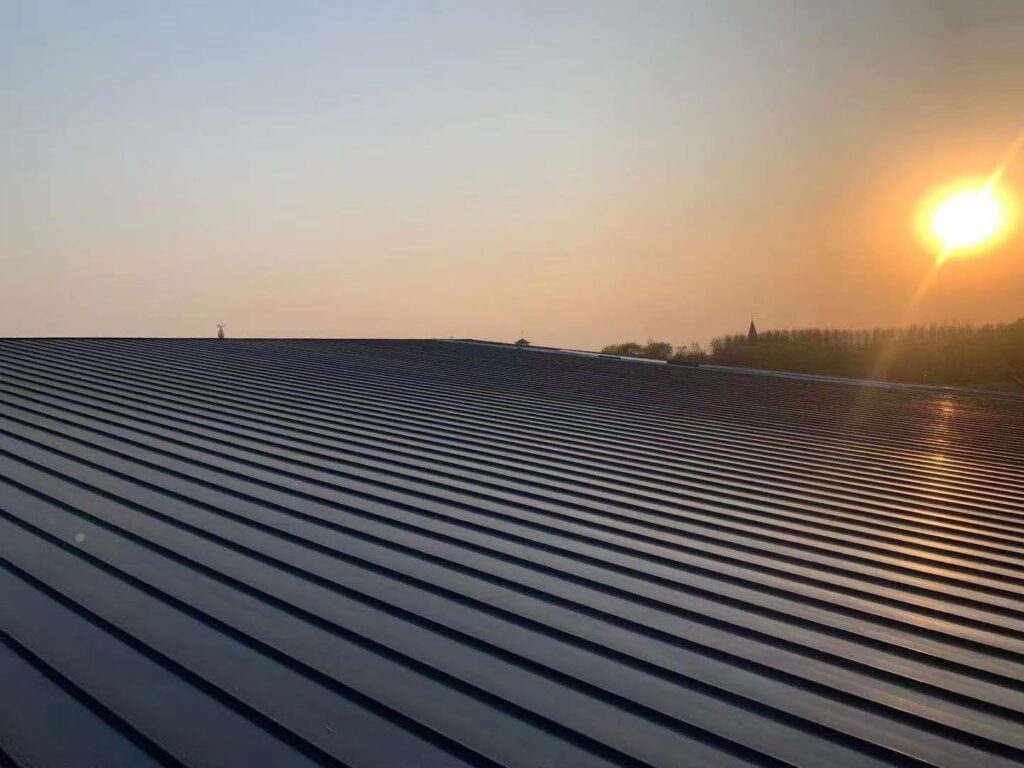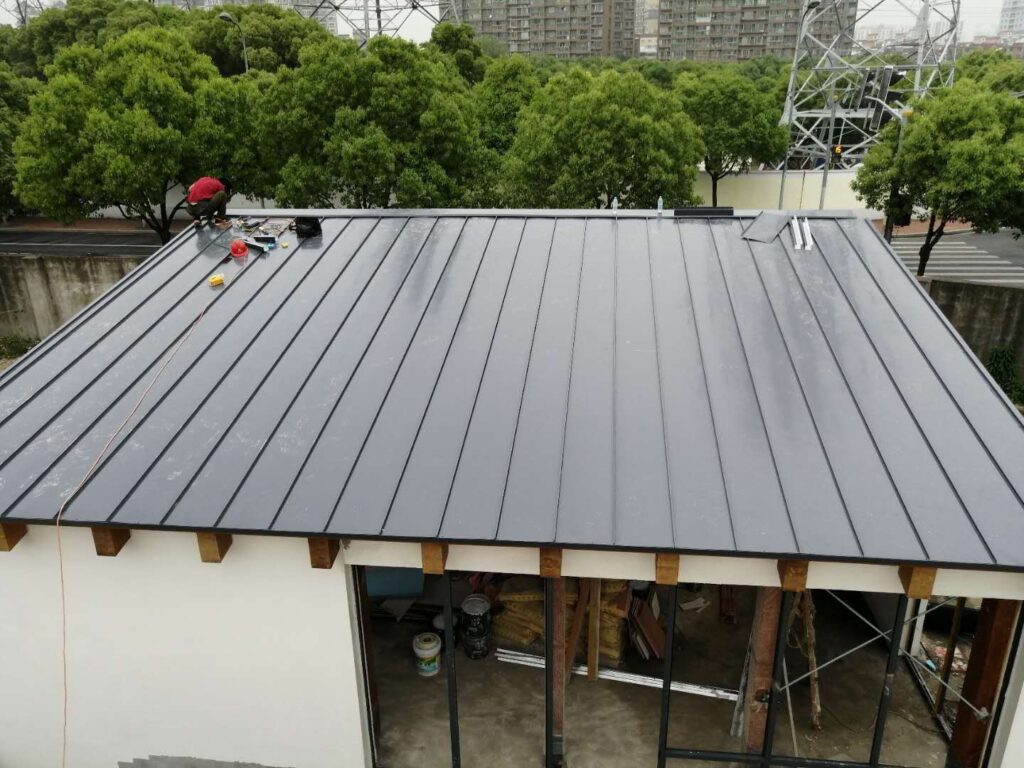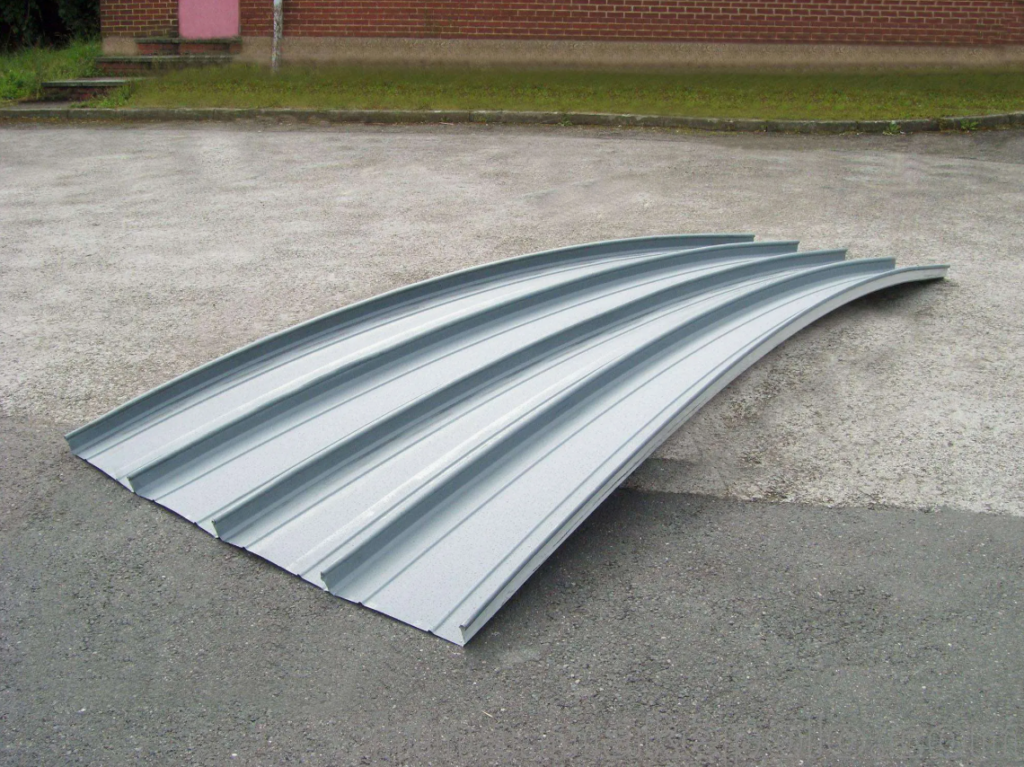Al-Mg-Mn roofing plate is a relatively new type of roofing material. Because of their characteristics and advantages, Al-Mg-Mn roofing plate has become a preferred material in modern construction. It combines aluminum, magnesium, and manganese to create a lightweight yet strong alloy. This material suits large-span roofs, airport terminals, exhibition halls, and industrial plants. Builders favor it for its excellent corrosion resistance, formability, and long service life.
The balance of strength and flexibility gives architects more design freedom. Compared with traditional roofing materials, Al-Mg-Mn plates reduce structural load and maintenance costs. As sustainability and efficiency become key goals in construction, this alloy continues to gain market attention.
Main Characteristics of Al-Mg-Mn Roofing Plates
The Al-Mg-Mn alloy offers several unique characteristics. First, it provides high strength with low density. The addition of magnesium and manganese improves the mechanical properties of aluminum. The plate maintains rigidity while remaining easy to shape. This makes it suitable for both curved and flat roofs.
Corrosion resistance is another core feature. The aluminum base forms a dense oxide layer that protects the surface from oxidation. The alloy also performs well in coastal and industrial environments where humidity and chemicals are common. Even after long exposure, the surface maintains its metallic brightness.
Good formability allows the plate to be processed into various profiles. It can be bent, rolled, or welded without cracking. This flexibility supports creative architectural designs. The material adapts easily to modern construction methods such as continuous roll forming.
In addition, Al-Mg-Mn plates have excellent weather resistance. They perform well under temperature changes, wind pressure, and snow loads. The material also resists ultraviolet aging, ensuring long-term stability.
Light weight is another valuable feature. The alloy weighs about one-third of steel, reducing the total load on the building structure. This helps lower foundation costs and simplifies installation.

Finally, the surface can be coated with color films or anodized finishes. These treatments enhance appearance and further increase corrosion resistance. The result is a roofing material that combines durability, beauty, and environmental performance.
Advantages of Al-Mg-Mn Roofing Plates
One of the biggest advantages is durability. The alloy resists corrosion and weathering much better than traditional materials. Even in harsh environments, it maintains structural integrity for decades. Builders can expect a service life of more than 30 years with proper protection.
Another major advantage is weight reduction. Because the material is light, it reduces the pressure on supporting frames. Lighter roofs require smaller steel structures, which cuts material and transportation costs. This feature is especially valuable in large public buildings and factories.
Energy efficiency is another benefit. Aluminum reflects sunlight and helps reduce indoor heat gain. Buildings with Al-Mg-Mn roofs often consume less energy for cooling. When combined with insulation layers, the energy-saving effect becomes even stronger.
Ease of installation also stands out. The material’s light weight allows quick handling and assembly. Contractors can complete projects faster and with fewer workers. Its flexibility supports large continuous panels, reducing joint leaks and improving waterproof performance.
From an environmental view, the alloy is highly recyclable. Old panels can be melted and reused with minimal energy consumption. Recycling does not weaken the material’s strength. This property aligns with the growing demand for sustainable building materials.

Aesthetic versatility adds to its value. The surface can take on various colors, textures, and finishes. Architects can design roofs that match the building’s style while maintaining technical performance. Modern coatings keep their color for years without fading.
Finally, Al-Mg-Mn plates require little maintenance. The protective oxide layer and coatings prevent corrosion and staining. Regular cleaning is usually enough to keep the roof in good condition. This long-term reliability lowers the overall cost of ownership.
Production Key Points
Producing high-quality Al-Mg-Mn roofing plates requires strict process control. Every stage—from alloy composition to surface finishing—affects performance and durability.
The first key aspect is raw material purity. The aluminum base must contain minimal impurities. Impurities can reduce corrosion resistance and mechanical strength. Proper alloying with magnesium and manganese ensures a stable microstructure. Manufacturers should follow precise formulas to maintain consistent quality.
Melting and casting conditions are equally important. Temperature and cooling rate must be carefully controlled. Improper cooling can cause internal stress or uneven grain size. These defects may lead to cracks during rolling or forming. Continuous casting technology helps produce uniform and stable sheets.
Rolling quality plays a major role. During cold or hot rolling, the plate must maintain accurate thickness and flatness. Uneven rolling can affect the roof’s appearance and sealing performance. Modern mills with automatic control systems ensure precise results.
Surface treatment is another critical step. Before coating, the plate must be cleaned and degreased thoroughly. Any remaining oil or dirt can weaken the bond between the coating and metal. Anodizing or color coating should follow strict thickness and temperature standards. Proper treatment not only improves corrosion resistance but also enhances color stability.
Forming and joining require attention as well. Although the material has good ductility, excessive bending or tension can cause cracks. Proper tools and forming speeds should be used. When welding, operators should control heat to avoid surface discoloration or structural distortion. For installation, mechanical joints are often preferred to reduce heat impact.
Storage and transportation also affect quality. Plates should be stored in dry areas and protected from rain or chemical exposure. Stacking pressure should remain low to prevent surface damage. During transport, soft materials can separate sheets and reduce scratching.

In summary
The Al-Mg-Mn roofing plate represents a major advancement in roofing materials. Its combination of strength, corrosion resistance, and light weight meets modern construction needs. The alloy performs well in diverse environments and offers long service life with minimal upkeep.
Its advantages extend beyond durability. The material saves energy, supports creative designs, and reduces structural costs. Its recyclability also aligns with sustainable building trends. Architects and engineers can rely on it for both performance and aesthetics.
However, achieving these benefits depends on careful manufacturing. From alloy preparation to final coating, each step requires precision. Strict quality control ensures consistent results and prevents future failures. Neglecting process details can reduce lifespan and performance.
As technology develops, the production of Al-Mg-Mn roofing plates continues to improve. Automation, better coatings, and advanced forming methods enhance both efficiency and quality. With proper manufacturing and installation, this material will continue to dominate the roofing market.
In modern architecture, the Al-Mg-Mn roofing plate stands for innovation and sustainability. It combines practical engineering advantages with visual appeal. Its success reflects the growing demand for materials that perform well and protect the environment. With its balance of beauty, strength, and longevity, it will remain a key choice for high-quality roofing projects worldwide.
Post time: Oct-23-2025

